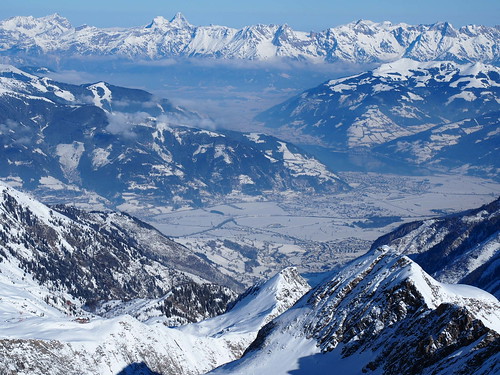
Our base is in the Austrian ski resort area of Kaprun, a small town a few kilometres from Zell-am-See and about 100 kilometres south-west of Salzburg. Nowadays it has adapted to the tourism associated with skiing, having some of the higher mountains close by and a glacier which can provide a snow experience throughout the whole year.
See Kaprun at the bottom of the valley, from my picture taken on the mountainside.
Right now Kaprun is part way through building two new gondola lifts from the centre of town which will link onto the route to the glacier. This significant civil engineering requires both a new cablecar system and also new roads and feeder infrastructure.

My diagram shows the planned new piece of infrastructure, which links right to the Langwied Mountain Station at around 1976 metres. Currently the way to get there involves a 6 km route out of Kaprun before reaching a base station at around 900 metres. Then it is separate routes at 1976m, then 2450m and finally 3029m to get to the top. The new route will go directly to the intermediate 1976m station and presumably will create a big new opportunity for the once farming village of Kaprun.

But these old pictures only tell a partial story of a village that came under Hermann Göring's rule as part of a German propaganda initiative.
In 1938, the Austrian Chancellor Schuschnigg had been bullied by Hitler into agreeing a greater Nazi presence within Austria. Schuschnigg hoped that agreeing to Hitler’s demands would prevent a German invasion. Instead, German foreign minister Göring faked a "plea" for German assistance from inside the Austrian government. Then German troops marched into Austria and Hitler announced his Anschluss (the so called Union of Austria and Germany).
Göring staged the start of construction of Kaprun Dams in 1938, as part of plans for a "Tauernkraftwerk" mountain hydro electricity power plant. There were no plans so he simply used a field and some men with shovels to create the propaganda.
Despite the lack of plans, forced labourers (i.e. slaves) were used to begin the construction in horrendous conditions. As the war started, prisoners including Polish, French and Soviet POWs, Italians, people from the territories of the Soviet Union (‘Ostarbeiter’) and Jews were used to continue the work on power station and on the dam above it in the valley.

By the end of 1944, work on the site had come to a halt, but not before a crude barrage had been constructed out of any materials available at the mountain camp in a desperate attempt to produce some electricity. The propaganda value of this Kaprun Hauptstufe was considerable, even though the amount of power generated was negligible.
After the war the construction of the original Kaprun dams stopped. Then, in 1947, it was started up again and advanced quickly, albeit with still extremely challenging conditions.

Initially, the revised projects were led by the Americans, and the still tough working environment deployed local Austrians and added a few features like the working camp cinema, as was to try to improve morale for this second wave of the project.

Quite quickly, in 1951, the 120 metre high Limberg wall was finished and one year later the main power plant started to operate. Also, in 1950, the construction of the second Kaprun Oberstufe Dam started. Finished five years later, the two dams are connected through a 12 kilometre tunnel.
We found out most of this from a small museum in Kaprun and subsequently I noticed this Austrian movie dramatisation of the second wave of construction. Incidentally, notice the 'Sound of Music' moment in this movie (0:50-ish), ten years before the actual Sound of Music was made.
No comments:
Post a Comment